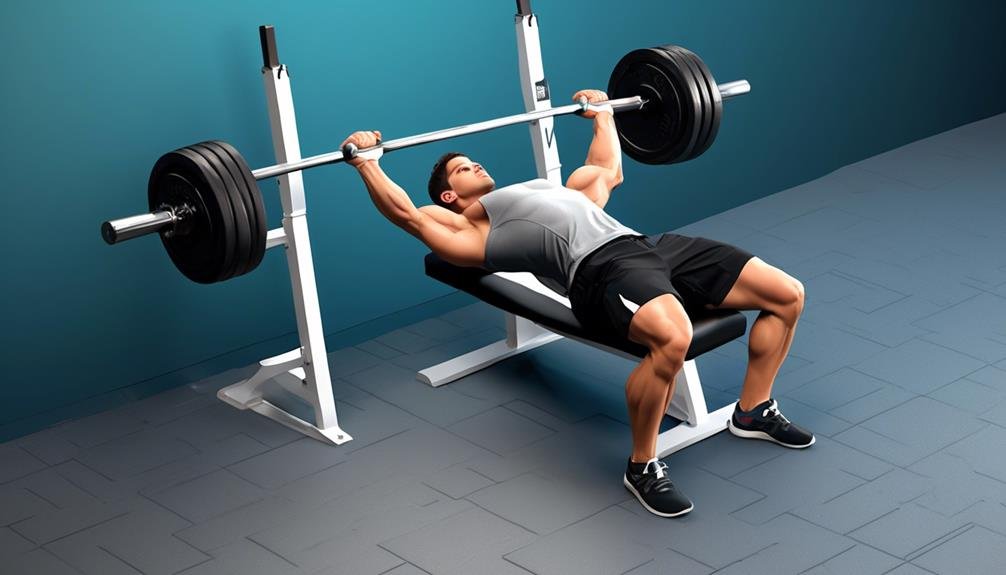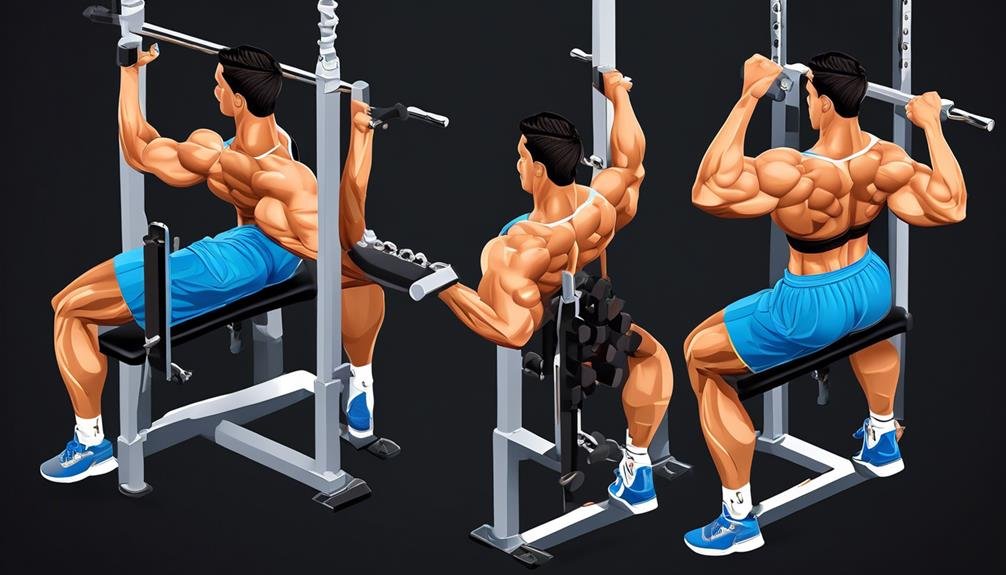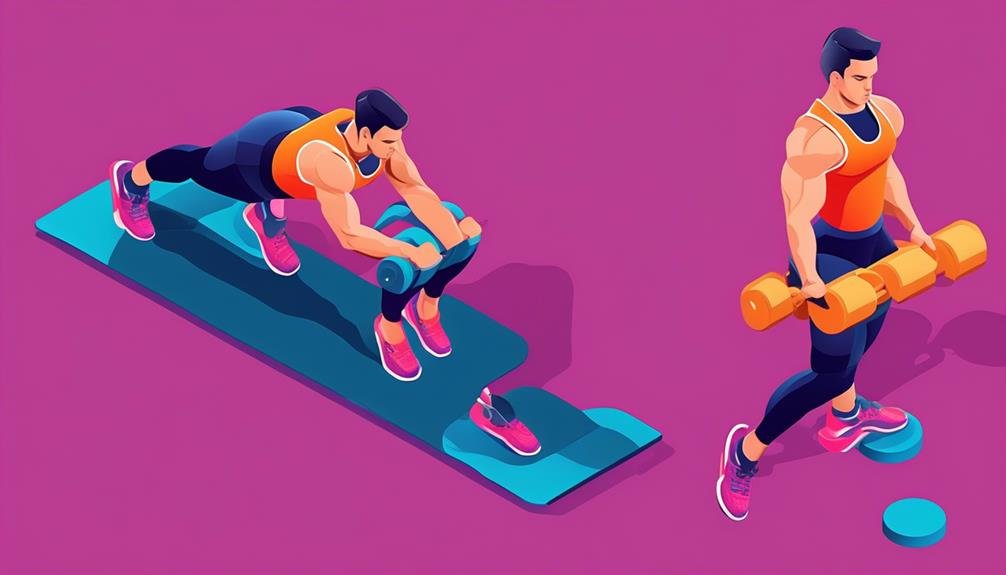Are you tired of hitting a plateau in your lifting progress? Well, you're not alone. Many individuals unknowingly undermine their own progress by making common technique mistakes. These simple errors can hinder your gains and put you at risk for injuries.
But fear not, as we delve into the discussion, we will uncover the most prevalent technique mistakes that may be hindering your lifting progress. Stay tuned to discover how you can avoid these pitfalls and take your lifting game to the next level.
Key Takeaways
- Sacrificing proper form for heavier weights can hinder lifting progress.
- Gradually increasing weight with proper form allows muscles to adapt and strengthen over time.
- Rest and recovery are crucial for lifting progress.
- Trying new exercises prevents boredom and keeps motivation high.
Head and Neck Yanking
Yanking your head and neck during crunches can be a common mistake that leads to discomfort and potential injury if not done correctly. When performing crunches, it's important to avoid any excessive pulling or jerking motions that can strain your neck muscles and put unnecessary stress on your cervical spine.
To prevent head and neck yanking, there are a few key techniques to keep in mind. First, place your fingertips and thumbs gently behind your head, avoiding any forceful gripping or pulling. This helps to support your neck and keeps it in a neutral position throughout the movement.
Additionally, keep your elbows wide and shoulders relaxed. This helps to distribute the workload evenly and reduces the temptation to use your neck muscles for added momentum. Another useful tip is to use the edges of your eyes to check if your shoulder placement is correct. If you can see your elbows in your peripheral vision, then you're likely maintaining good form.
Leaning During Squats
When it comes to squats, one common mistake to avoid is leaning too much, which can put excessive pressure on your knees and compromise your form. To ensure you're performing squats correctly and maximizing your gains, here are a few key tips to keep in mind:
- Keep your feet and hips apart: Position your feet shoulder-width apart and keep your hips in line with your feet. This will help you maintain stability and balance throughout the movement.
- Point your toes straight or slightly outward: Angling your toes slightly outward can help you engage your glutes and hamstrings more effectively during the squat.
- Squat down with knees in line with toes: As you lower into the squat, make sure your knees are moving in the same direction as your toes. This will help you avoid any unnecessary strain on your knees.
Curving Back in Bench Press

To maintain proper form and avoid the risk of injury, it's crucial to avoid curving your back during bench press. Curving your back can undermine the effectiveness of the exercise and increase the chances of hurting yourself.
When performing the bench press, it's important to keep your back in contact with the bench at all times. Avoid arching your back to unusual positions and focus on maintaining a stable and neutral spine.
Remember, the amount of weight lifted doesn't determine the strength of your chest muscles. It's much more important to prioritize proper form and technique. Listen to your body and avoid compromising your form by trying to lift more weight than you can handle.
Pay attention to any discomfort or pain and make adjustments as necessary. By maintaining a straight back and proper form, you can maximize the benefits of the bench press while minimizing the risk of injury.
Lowering Arms Too Much in Chest Exercises
Avoid excessively lowering your arms during chest exercises to prevent strain and potential injuries to your shoulder and chest muscles. Lowering your arms too much can put unnecessary stress on these muscles, increasing the risk of discomfort and injury.
To ensure a safe and effective workout, follow these guidelines:
- Maintain proper form: Keep your arms and elbows slightly above chest level. This position helps to engage the chest muscles while minimizing strain on the shoulders.
- Focus on a safe range of motion: Instead of trying to achieve a deeper range of motion, prioritize maintaining proper form and technique. This will help prevent joint injuries and promote muscle activation.
- Listen to your body: Pay attention to any pain or discomfort during chest exercises. If you experience any, stop and reassess your form. Adjust the range of motion or the amount of weight you're using to ensure a safe and effective workout.
Incorrect Lat Pull-down Bar Technique

Continuing our discussion on common technique mistakes in lifting, let's now address the incorrect lat pull-down bar technique, which can put unnecessary strain on your shoulder joints and muscles. It's crucial to avoid pulling the bar straight down to your lap, as this can endanger your shoulders. Instead, focus on pulling the bar to the top of your chest. This will ensure that your muscles are properly engaged and that you aren't relying on momentum to complete the exercise.
To execute the lat pull-down correctly, start by sitting down and positioning your thighs under the thigh bar. Lean slightly backward and lift your chest to meet the bar as you pull it down. Remember to maintain control throughout the movement and avoid pulling the bar unevenly.
Using the proper weight lifting technique for lat pulls is also essential. Choose a weight that allows you to perform the exercise with proper form and without straining your shoulders.
Sitting Too Quickly After Bench Exercises
Sitting too quickly after bench exercises can have negative effects on your body and should be avoided. It's important to give your body time to adjust after the exertion of bench exercises. Rushing to sit up can lead to dizziness and potential injury. To prevent this, make sure to allow your body to gradually transition from the bench to a standing position. Take a moment to catch your breath and regain stability before standing up. This will help you avoid feeling lightheaded and prevent strains on your lower back.
Here are some tips to keep in mind:
- Allow your body to adjust: Give your muscles and cardiovascular system time to recover after bench exercises.
- Take it slow: Avoid the temptation to quickly sit up after finishing your sets. Instead, take your time and transition gradually.
- Regain stability: Before standing up, take a moment to catch your breath and ensure you feel balanced and stable.
Raising Hips off Support Pad in Leg Curls

To maximize the effectiveness of your leg curls, it's crucial to maintain contact between your hips and the support pad, avoiding any lifting or shifting movements. Raising your hips off the support pad during leg curls is a common technique mistake that can undermine your lifting progress. When you lift your hips too high, it reduces the activation of your hamstrings, which are the primary muscles targeted in this exercise. Instead, focus on keeping your hips firmly pressed against the support pad throughout the movement.
By maintaining contact between your hips and the support pad, you ensure that your hamstrings are fully engaged and working to their maximum potential. Lifting your hips off the support pad shifts the focus away from the hamstrings and onto your lower back, increasing the risk of strain and injury. To prevent this, engage your core muscles to stabilize the pelvis and prevent excessive hip lifting during leg curls.
When performing leg curls, it's important to prioritize a controlled and smooth movement. Avoid any jerky or abrupt hip movements that compromise your form and muscle engagement. By maintaining proper technique and focusing on keeping your hips in contact with the support pad, you can maximize the effectiveness of your leg curls and make progress towards your lifting goals.
Common Mistakes in Lifting Progress
As you progress in your lifting journey, it's important to be aware of common mistakes that can hinder your progress and increase the risk of injury. Here are some common mistakes to watch out for:
- Compromising your form: One of the biggest mistakes people make is sacrificing proper form for the sake of lifting heavier weights. Remember, using proper form is crucial for targeting the intended muscle groups and preventing injuries. Focus on maintaining correct posture, alignment, and movement throughout your lifts.
- Lifting too much weight: It can be tempting to constantly increase the amount of weight you lift, but doing so too quickly or without proper preparation can lead to injuries. Gradually progress the weight you lift to allow your muscles and connective tissues to adapt and strengthen over time.
- Neglecting recovery and rest: Many people underestimate the importance of rest and recovery in their lifting progress. Your muscles need time to repair and grow stronger after each workout. Overtraining can lead to fatigue, decreased performance, and an increased risk of injury. Make sure to incorporate rest days into your training schedule and prioritize adequate sleep and nutrition.
Frequently Asked Questions
What Is the Most Common Mistake When Lifting?
The most common mistake when lifting is compromising form for heavy weights. This can lead to injury and hinder progress. Prioritize proper technique, balance rest and workout days, have a structured plan, target the right muscle groups, and maintain proper nutrition.
What Can Incorrect Weight Training Technique Lead To?
Incorrect weight training technique can lead to muscle strain, potential injury, and increased risk of injury. Yanking the head and neck during crunches, excessive leaning during squats, curving the back during bench press, and using the lat pull-down bar incorrectly can all undermine lifting progress.
Why It Is Important to Correct Client Technique During Exercise if It Is Being Performed Incorrectly?
It's important to correct your technique during exercise if it's incorrect because it helps prevent injury, targets the right muscles, promotes muscle growth, and leads to quicker progress.
What Are the Risks of Weight Lifting?
Weight lifting can be risky if you make mistakes. You risk neck pain and injury from yanking your head during crunches. Leaning too much in squats can hurt your knees. Curving your back during bench press can lead to injury. Lowering elbows too much in chest exercises can cause muscle injuries. Pulling a lat pull-down bar incorrectly can harm your shoulders.
Conclusion
To ensure optimal lifting progress, it's crucial to avoid common technique mistakes that can hinder results and lead to injuries.
By maintaining proper form and technique, gradually increasing intensity, prioritizing rest and recovery, and focusing on proper training and nutrition, you can maximize the effectiveness of your workouts and prevent setbacks.
Remember to warm up and cool down properly and avoid yanking the head and neck, leaning too much, curving the back, lowering the arms excessively, and using incorrect techniques with equipment.
